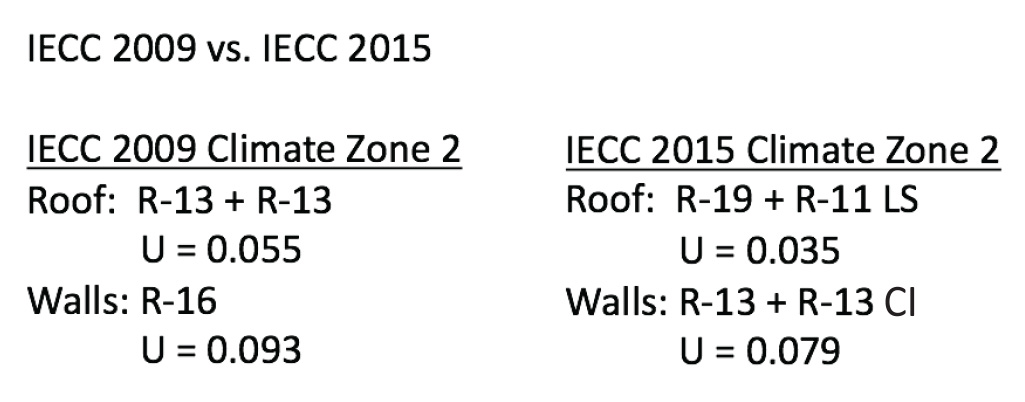Envelope-Based Solutions for Metal Buildings
Energy Codes and Building Envelope
Energy codes are divided into three major categories: building envelope, HVAC and lighting. For this discussion, we are primarily concerned with the building envelope—specifically, opaque roof and wall assemblies. Codes specify insulation levels for metal building floors, ceilings, roofs and walls, and include requirements for protecting and sealing a building against air leakage and moisture migration. The Climate Zone in which a building is located has an impact on envelope requirements. IECC and ASHRAE 90.1 envelope tables are sorted by climate zone. In general, the higher or colder the climate zone, the more stringent the requirements.
Appendix A of ASHRAE 90.1 includes tables (Metal Building Insulation Tables A2.3 and A3.2) that depict the minimum R-values for insulation and maximum U-factors for the entire assembly of different generic assemblies—for example, a standing seam metal roof with a single layer of insulation and thermal spacers.
U-factors have come into play during the last few code cycles. Rather than considering individual components, the U-factor measures the thermal conductivity of the entire assembly, taking into consideration framing, fasteners, spacing of framing and fasteners, and whether insulation is compressed or fully expanded. The U-factor is the inverse of the R-value; consequently, a lower U-factor indicates better performance.
Considering an entire assembly with the U-factor method allows an architect or designer to specify an assembly that is not described explicitly, if it has a U-factor equal or less than that specified in the tables. We will re-visit this concept in the section on compliance.
The Impact of Stricter Energy Codes
To understand the effect of more stringent code requirements, let’s look at a specific example comparing IECC 2009 and IECC 2015 prescriptive requirements for insulation for roof and walls in Climate Zone 2. In general, older codes allow a single or double layer of fiberglass insulation compressed over the purlins. Experienced builders have been accustomed to installing single-layer roof and wall systems to meet code and could consider anything other than single-layer applications “overkill.”
But newer codes require higher R-values (and lower U-factors). For example, IECC 2009 first introduced the requirement of continuous insulation (ci) in metal building wall assemblies for climate zones 5-8. IECC 2015 calls for ci in metal building wall assemblies and higher performing roof assemblies across all climate zones.
Going back to our specific example, IECC 2015 requires significantly higher total R-values than IECC 2009 (R-19 and R-11 versus R-13 + R-13, respectively). In addition, IECC 2015 specifies the use of a liner system (LS). A liner system consists of a continuous membrane installed below the purlins, uninterrupted by framing members. Unfaced insulation sits on top of the membrane and between the purlins. Thermal spacers must be used with this assembly, unless the U-factor method is employed.
For walls, IECC 2009 simply requires R-16, usually fiberglass insulation, but IECC 2015 requires a two-layer system: R-13 fiberglass + R-13 of ci. The ci typically consists of rigid insulation board.
Obviously, the IECC 2015 requirements are both more stringent and more complicated, requiring additional materials, labor and knowledge. When architects start to incorporate these assemblies into their drawings and specs, it can leave builders puzzled.
Builders may not know how to construct these new assemblies. On the other hand, if they ignore newer code requirements in their area, they run the risk of not meeting code, preventing the end user from occupying the building. They also may be burdened with the expense of installing additional insulating materials after the building has been erected.

Compliance Options
Two main compliance paths are available: the prescriptive method and the performance-based option.
Prescriptive Method
Often referred to as the cookbook method, building professionals who choose this method follow all values exactly as presented in the code book tables. The prescriptive method is a fast, definitive and conservative approach to code compliance. Materials and equipment must meet a certain level of stringency, which is quantified in tables. The tables list the minimum and maximum requirements for the R-values and U-factors of materials, the allowable watts per-square-foot of lighting systems, and the minimum energy efficiencies required of mechanical systems. This path dictates specific requirements that must be met, but it does not account for potential energy saving features such as window orientation.
There is some flexibility in this approach as it allows the designer to select different options for various assemblies. For example, the code may call for a particular roof assembly and list an equivalent R-value and U-factor. The designer has the freedom to substitute a different assembly with an equal or lower U-factor, as long as documentation is provided to back up performance. This is known as “U-factor compliance.”
It is important to understand that prescriptive values are based on assumptions about potential building performance. For example, insulation requirements for a metal building roof in Climate Zone 2 might be listed as (minimum) R-19 and (maximum) U-0.065. This assumes that the purlins are spaced at least 5 feet apart, and that thermal spacers are used. If the project does not meet these conditions, R-19 may not be appropriate for the desired thermal protection or adequate for code compliance.
Performance-based Method
Another way of achieving energy code compliance is through the performance-based method. It offers more flexibility in design as the building is viewed as a whole in lieu of a combination of individual components. Based on computer energy modeling, it allows for building envelope components with an increased performance to offset other components with reduced performance. The proposed building design is compared to a base-line reference building to demonstrate that the envelope performance of the proposed building is as or more efficient than the envelope performance of the base-line building. Although this approach offers more flexibility in design, it entails highly detailed and technical documentation.









